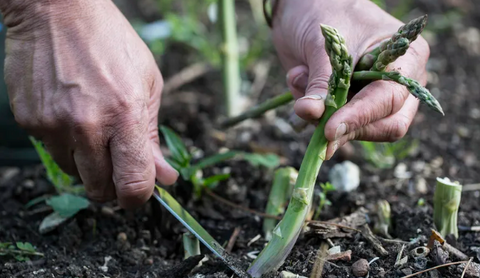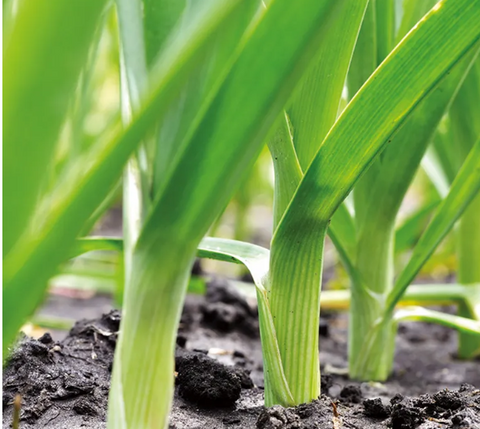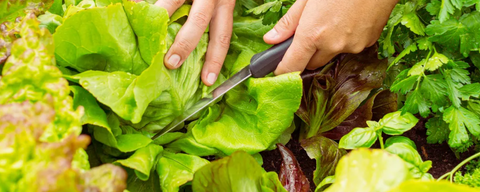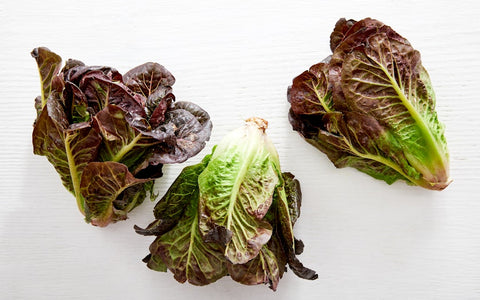Introduction
Welcome to the fascinating world of companion planting, where the art of cultivation meets the science of symbiosis. In this guide, we explore the intricate dance of pairing asparagus with its perfect companions to unlock a garden's full potential. Discover how strategic plant pairings can enhance soil health, deter pests, and maximize yields. From marigolds to chives, each companion offers unique features that benefit both the asparagus and the garden ecosystem. Join us as we delve into the world of asparagus and its perfect companions and transform your garden into a thriving oasis of harmony and abundance.

Understanding Companion Planting
Companion planting is a time-honored gardening technique that involves growing different plant species together for mutual benefit. The fundamental principle behind companion planting is to create symbiotic relationships between plants, where each species contributes to the overall health and vitality of the garden ecosystem. By harnessing the power of companion planting, gardeners can create a balanced and resilient environment where plants thrive in harmony.
The Benefits of Companion Planting with Asparagus
Companion planting offers a range of benefits when it comes to growing asparagus. By carefully selecting companion plants, you can:
● Enhance soil fertility and structure: Certain companion plants, such as nitrogen-fixing legumes, can help replenish soil nutrients and improve soil texture, creating an ideal growing environment for asparagus.
● Improve pest management and reduce disease incidence: Many companion plants possess natural pest-repelling properties, helping to deter common pests that can damage asparagus crops. Additionally, some companion plants can attract beneficial insects that prey on pests, further enhancing pest control efforts.
● Maximize garden space and promote biodiversity: Intercropping asparagus with companion plants allows you to make the most of limited garden space while promoting biodiversity. By carefully selecting companion plants with complementary growth habits, you can optimize space utilization and create a diverse and productive garden ecosystem.
Companion Plants for Asparagus
When it comes to companion planting with asparagus, there are several options to consider:
Best companion plants for pest control:
● Marigolds: These vibrant annuals are not only beautiful additions to the garden but also effective at repelling nematodes, and microscopic worms that can damage asparagus roots.
● Nasturtiums: Known for their edible flowers and peppery leaves, nasturtiums also act as natural pest deterrents, particularly against aphids and beetles.
● Chives: These flavorful herbs not only add a zing to your culinary creations but also repel aphids and carrot rust flies, two common pests that can affect asparagus.

Companion plants for soil improvement:
● Legumes such as peas and beans: These nitrogen-fixing plants have the remarkable ability to convert atmospheric nitrogen into a form that plants can use, helping to enrich the soil with this essential nutrient.
● Clover: A low-growing ground cover, clover helps prevent soil erosion and suppress weed growth while adding nitrogen to the soil.
● Comfrey: Often referred to as "nature's fertilizer," comfrey accumulates nutrients from deep within the soil and makes them available to other plants through its deep taproot.
Companion plants for maximizing garden space:
● Lettuce: With its shallow root system and compact growth habit, lettuce is an excellent choice for intercropping with young asparagus plants, allowing you to make the most of the available space.
● Radishes: These fast-growing vegetables can be sown between rows of asparagus to utilize vertical space and help loosen compacted soil with their vigorous root systems.
● Tomatoes: Tall and sprawling, tomatoes provide shade for the asparagus bed while also enhancing soil structure with their deep root systems.
Strategies for Successful Companion Planting
To maximize the benefits of companion planting with asparagus, consider the following strategies:
● Planning your asparagus bed layout: Before planting, carefully plan your asparagus bed layout to incorporate companion plants effectively. Take into account factors such as sunlight requirements, soil preferences, and growth habits to ensure compatibility and optimize space utilization.
● Rotating companion plants: Rotate companion plants regularly to prevent nutrient depletion and pest buildup. By rotating crops, you can also minimize the risk of soil-borne diseases and maintain a healthy and balanced garden ecosystem.
● Monitoring plant interactions: Keep an eye on how your companion plants interact with each other and with your asparagus. Adjust planting arrangements as needed to ensure that each plant has sufficient space and resources to thrive, and be prepared to intervene if any issues arise.

Tips for Pest Control in Asparagus Companion Planting
Pest control is a crucial aspect of successful companion planting with asparagus. Here are some tips to help you manage pests effectively:
● Implementing companion planting combinations: Choose companion plants that naturally deter common asparagus pests. For example, interplanting marigolds, nasturtiums, and chives with your asparagus can help repel nematodes, aphids, and carrot rust flies.
● Using natural pest control methods: In addition to companion planting, consider using other natural pest control methods such as introducing beneficial insects like ladybugs and lacewings, which feed on aphids and other harmful insects that may affect your asparagus crop. You can also attract beneficial predators by planting flowers such as yarrow, dill, and fennel, which provide nectar and habitat for these helpful insects.
Regularly inspect your plants for signs of pest infestation, such as yellowing leaves, holes in foliage, or distorted growth. Early detection is key to preventing pest damage from spreading and causing significant harm to your asparagus and companion plants. If you notice any signs of pest activity, take prompt action to address the issue using organic pest control methods, such as handpicking pests, applying insecticidal soap or neem oil, or using physical barriers like row covers to protect your plants.
Soil Improvement Techniques for Asparagus Companion Planting
Healthy soil is essential for the success of your asparagus bed, and companion planting can help improve soil fertility and structure over time. Here are some soil improvement techniques to consider:
● Incorporating nitrogen-fixing legumes: Rotate nitrogen-fixing legumes such as peas and beans with your asparagus to replenish soil nitrogen levels naturally. These legumes have specialized root nodules that host nitrogen-fixing bacteria, which convert atmospheric nitrogen into a form that plants can use for growth. When the legumes are incorporated back into the soil, they release this stored nitrogen, benefiting neighboring plants like asparagus.
● Mulching with organic materials: Mulching your asparagus bed with organic materials such as straw, compost, or shredded leaves can help improve soil structure and moisture retention. Mulch acts as a protective layer, insulating the soil from temperature extremes, reducing weed growth, and conserving soil moisture. As the mulch breaks down over time, it also adds organic matter to the soil, enriching it with essential nutrients and improving overall soil health.
● Applying compost and organic fertilizers: Regularly apply compost and organic fertilizers to your asparagus bed to replenish soil nutrients and enhance microbial activity. Compost is rich in organic matter and beneficial microorganisms, which help improve soil structure, increase nutrient availability and support healthy plant growth. Organic fertilizers such as composted manure, fish emulsion, or seaweed extract provide additional nutrients that can boost the growth and productivity of your asparagus and companion plants.

Maximizing Garden Space with Asparagus Companion Planting
Space is often limited in the garden, but companion planting offers a creative solution for maximizing space efficiency and productivity. Here are some tips for maximizing garden space with asparagus companion planting:
● Intercropping with fast-growing vegetables and herbs: Interplant fast-growing vegetables and herbs with your asparagus to make the most of available space. Plants like lettuce, spinach, and arugula have shallow root systems and compact growth habits, making them ideal candidates for intercropping with asparagus. By planting these crops between rows of asparagus or in the spaces between individual plants, you can maximize space utilization and increase overall garden productivity.
● Vertical gardening techniques: Explore vertical gardening techniques such as trellising, stacking, and hanging baskets to grow companion plants alongside your asparagus vertically. Vining plants like cucumbers, pole beans, and indeterminate tomatoes can be trained to climb trellises or stakes, allowing you to grow them vertically and save valuable ground space. Consider installing vertical structures such as arbors, A-frames, or teepees to support climbing plants and create a vertical garden display that maximizes space efficiency.
● Incorporating perennial companion plants: Integrate perennial companion plants into your garden design to make the most of limited space while promoting long-term biodiversity and sustainability. Perennial herbs like thyme, sage, and oregano provide year-round culinary delights while attracting beneficial insects and adding ornamental value to the garden. Fruit trees, berry bushes, and perennial flowers also make excellent companions for asparagus, providing shade, habitat, and food for pollinators while maximizing space utilization and enhancing garden diversity.
Common Mistakes to Avoid in Asparagus Companion Planting
While companion planting can offer numerous benefits for your asparagus bed, there are some common mistakes to avoid to ensure success:
● Overcrowding the asparagus bed: Resist the temptation to overcrowd your asparagus bed with too many companion plants. Overcrowding can lead to competition for resources such as sunlight, water, and nutrients, resulting in reduced yields and stunted growth for both asparagus and companion plants. Instead, give each plant ample space to spread out and thrive, taking into account their specific growth habits and space requirements.
● Choosing incompatible companion plants: Be mindful of the compatibility of companion plants when selecting species to grow alongside your asparagus. Some plants may compete with asparagus for resources or release allelopathic compounds that inhibit its growth. Before interplanting companion plants with your asparagus, research their compatibility and potential interactions to ensure that they will complement rather than hinder each other's growth.
● Neglecting maintenance and care: Proper maintenance and care are essential for the success of your asparagus companion planting efforts. Be sure to regularly water, weed, and fertilize your garden to ensure that all plants receive the nutrients and care they need to thrive. Monitor for signs of pest or disease infestation, and take prompt action to address any issues before they escalate and cause significant damage to your crops. By staying vigilant and proactive in your garden care routine, you can ensure the success of your asparagus companion planting efforts and enjoy a bountiful harvest year after year.
Conclusion
In conclusion, companion planting offers a wealth of benefits for asparagus growers, from enhancing soil fertility and pest management to maximizing garden space and promoting biodiversity. By strategically selecting companion plants and implementing thoughtful garden design techniques, you can create a thriving ecosystem where asparagus and companion plants coexist harmoniously, supporting each other's growth and productivity. So why not experiment with companion planting in your own garden and reap the rewards of a healthier, more productive garden? With some planning and creativity, you can transform your asparagus patch into a vibrant oasis of biodiversity and abundance. Happy gardening!
Welcome to the fascinating world of companion planting, where the art of cultivation meets the science of symbiosis. In this guide, we explore the intricate dance of pairing asparagus with its perfect companions to unlock a garden's full potential. Discover how strategic plant pairings can enhance soil health, deter pests, and maximize yields. From marigolds to chives, each companion offers unique features that benefit both the asparagus and the garden ecosystem. Join us as we delve into the world of asparagus and its perfect companions and transform your garden into a thriving oasis of harmony and abundance.

Understanding Companion Planting
Companion planting is a time-honored gardening technique that involves growing different plant species together for mutual benefit. The fundamental principle behind companion planting is to create symbiotic relationships between plants, where each species contributes to the overall health and vitality of the garden ecosystem. By harnessing the power of companion planting, gardeners can create a balanced and resilient environment where plants thrive in harmony.
The Benefits of Companion Planting with Asparagus
Companion planting offers a range of benefits when it comes to growing asparagus. By carefully selecting companion plants, you can:
● Enhance soil fertility and structure: Certain companion plants, such as nitrogen-fixing legumes, can help replenish soil nutrients and improve soil texture, creating an ideal growing environment for asparagus.
● Improve pest management and reduce disease incidence: Many companion plants possess natural pest-repelling properties, helping to deter common pests that can damage asparagus crops. Additionally, some companion plants can attract beneficial insects that prey on pests, further enhancing pest control efforts.
● Maximize garden space and promote biodiversity: Intercropping asparagus with companion plants allows you to make the most of limited garden space while promoting biodiversity. By carefully selecting companion plants with complementary growth habits, you can optimize space utilization and create a diverse and productive garden ecosystem.
Companion Plants for Asparagus
When it comes to companion planting with asparagus, there are several options to consider:
Best companion plants for pest control:
● Marigolds: These vibrant annuals are not only beautiful additions to the garden but also effective at repelling nematodes, and microscopic worms that can damage asparagus roots.
● Nasturtiums: Known for their edible flowers and peppery leaves, nasturtiums also act as natural pest deterrents, particularly against aphids and beetles.
● Chives: These flavorful herbs not only add a zing to your culinary creations but also repel aphids and carrot rust flies, two common pests that can affect asparagus.

Companion plants for soil improvement:
● Legumes such as peas and beans: These nitrogen-fixing plants have the remarkable ability to convert atmospheric nitrogen into a form that plants can use, helping to enrich the soil with this essential nutrient.
● Clover: A low-growing ground cover, clover helps prevent soil erosion and suppress weed growth while adding nitrogen to the soil.
● Comfrey: Often referred to as "nature's fertilizer," comfrey accumulates nutrients from deep within the soil and makes them available to other plants through its deep taproot.
Companion plants for maximizing garden space:
● Lettuce: With its shallow root system and compact growth habit, lettuce is an excellent choice for intercropping with young asparagus plants, allowing you to make the most of the available space.
● Radishes: These fast-growing vegetables can be sown between rows of asparagus to utilize vertical space and help loosen compacted soil with their vigorous root systems.
● Tomatoes: Tall and sprawling, tomatoes provide shade for the asparagus bed while also enhancing soil structure with their deep root systems.
Strategies for Successful Companion Planting
To maximize the benefits of companion planting with asparagus, consider the following strategies:
● Planning your asparagus bed layout: Before planting, carefully plan your asparagus bed layout to incorporate companion plants effectively. Take into account factors such as sunlight requirements, soil preferences, and growth habits to ensure compatibility and optimize space utilization.
● Rotating companion plants: Rotate companion plants regularly to prevent nutrient depletion and pest buildup. By rotating crops, you can also minimize the risk of soil-borne diseases and maintain a healthy and balanced garden ecosystem.
● Monitoring plant interactions: Keep an eye on how your companion plants interact with each other and with your asparagus. Adjust planting arrangements as needed to ensure that each plant has sufficient space and resources to thrive, and be prepared to intervene if any issues arise.

Tips for Pest Control in Asparagus Companion Planting
Pest control is a crucial aspect of successful companion planting with asparagus. Here are some tips to help you manage pests effectively:
● Implementing companion planting combinations: Choose companion plants that naturally deter common asparagus pests. For example, interplanting marigolds, nasturtiums, and chives with your asparagus can help repel nematodes, aphids, and carrot rust flies.
● Using natural pest control methods: In addition to companion planting, consider using other natural pest control methods such as introducing beneficial insects like ladybugs and lacewings, which feed on aphids and other harmful insects that may affect your asparagus crop. You can also attract beneficial predators by planting flowers such as yarrow, dill, and fennel, which provide nectar and habitat for these helpful insects.
Regularly inspect your plants for signs of pest infestation, such as yellowing leaves, holes in foliage, or distorted growth. Early detection is key to preventing pest damage from spreading and causing significant harm to your asparagus and companion plants. If you notice any signs of pest activity, take prompt action to address the issue using organic pest control methods, such as handpicking pests, applying insecticidal soap or neem oil, or using physical barriers like row covers to protect your plants.
Soil Improvement Techniques for Asparagus Companion Planting
Healthy soil is essential for the success of your asparagus bed, and companion planting can help improve soil fertility and structure over time. Here are some soil improvement techniques to consider:
● Incorporating nitrogen-fixing legumes: Rotate nitrogen-fixing legumes such as peas and beans with your asparagus to replenish soil nitrogen levels naturally. These legumes have specialized root nodules that host nitrogen-fixing bacteria, which convert atmospheric nitrogen into a form that plants can use for growth. When the legumes are incorporated back into the soil, they release this stored nitrogen, benefiting neighboring plants like asparagus.
● Mulching with organic materials: Mulching your asparagus bed with organic materials such as straw, compost, or shredded leaves can help improve soil structure and moisture retention. Mulch acts as a protective layer, insulating the soil from temperature extremes, reducing weed growth, and conserving soil moisture. As the mulch breaks down over time, it also adds organic matter to the soil, enriching it with essential nutrients and improving overall soil health.
● Applying compost and organic fertilizers: Regularly apply compost and organic fertilizers to your asparagus bed to replenish soil nutrients and enhance microbial activity. Compost is rich in organic matter and beneficial microorganisms, which help improve soil structure, increase nutrient availability and support healthy plant growth. Organic fertilizers such as composted manure, fish emulsion, or seaweed extract provide additional nutrients that can boost the growth and productivity of your asparagus and companion plants.

Maximizing Garden Space with Asparagus Companion Planting
Space is often limited in the garden, but companion planting offers a creative solution for maximizing space efficiency and productivity. Here are some tips for maximizing garden space with asparagus companion planting:
● Intercropping with fast-growing vegetables and herbs: Interplant fast-growing vegetables and herbs with your asparagus to make the most of available space. Plants like lettuce, spinach, and arugula have shallow root systems and compact growth habits, making them ideal candidates for intercropping with asparagus. By planting these crops between rows of asparagus or in the spaces between individual plants, you can maximize space utilization and increase overall garden productivity.
● Vertical gardening techniques: Explore vertical gardening techniques such as trellising, stacking, and hanging baskets to grow companion plants alongside your asparagus vertically. Vining plants like cucumbers, pole beans, and indeterminate tomatoes can be trained to climb trellises or stakes, allowing you to grow them vertically and save valuable ground space. Consider installing vertical structures such as arbors, A-frames, or teepees to support climbing plants and create a vertical garden display that maximizes space efficiency.
● Incorporating perennial companion plants: Integrate perennial companion plants into your garden design to make the most of limited space while promoting long-term biodiversity and sustainability. Perennial herbs like thyme, sage, and oregano provide year-round culinary delights while attracting beneficial insects and adding ornamental value to the garden. Fruit trees, berry bushes, and perennial flowers also make excellent companions for asparagus, providing shade, habitat, and food for pollinators while maximizing space utilization and enhancing garden diversity.
Common Mistakes to Avoid in Asparagus Companion Planting
While companion planting can offer numerous benefits for your asparagus bed, there are some common mistakes to avoid to ensure success:
● Overcrowding the asparagus bed: Resist the temptation to overcrowd your asparagus bed with too many companion plants. Overcrowding can lead to competition for resources such as sunlight, water, and nutrients, resulting in reduced yields and stunted growth for both asparagus and companion plants. Instead, give each plant ample space to spread out and thrive, taking into account their specific growth habits and space requirements.
● Choosing incompatible companion plants: Be mindful of the compatibility of companion plants when selecting species to grow alongside your asparagus. Some plants may compete with asparagus for resources or release allelopathic compounds that inhibit its growth. Before interplanting companion plants with your asparagus, research their compatibility and potential interactions to ensure that they will complement rather than hinder each other's growth.
● Neglecting maintenance and care: Proper maintenance and care are essential for the success of your asparagus companion planting efforts. Be sure to regularly water, weed, and fertilize your garden to ensure that all plants receive the nutrients and care they need to thrive. Monitor for signs of pest or disease infestation, and take prompt action to address any issues before they escalate and cause significant damage to your crops. By staying vigilant and proactive in your garden care routine, you can ensure the success of your asparagus companion planting efforts and enjoy a bountiful harvest year after year.
Conclusion
In conclusion, companion planting offers a wealth of benefits for asparagus growers, from enhancing soil fertility and pest management to maximizing garden space and promoting biodiversity. By strategically selecting companion plants and implementing thoughtful garden design techniques, you can create a thriving ecosystem where asparagus and companion plants coexist harmoniously, supporting each other's growth and productivity. So why not experiment with companion planting in your own garden and reap the rewards of a healthier, more productive garden? With some planning and creativity, you can transform your asparagus patch into a vibrant oasis of biodiversity and abundance. Happy gardening!









